Kenneth L. Gentry Jr.'s Blog, page 33
September 30, 2022
THE LAND BEAST & GREAT SIGNS (2)
 PMW 2022-074 by Kenneth L. Gentry, Jr.
PMW 2022-074 by Kenneth L. Gentry, Jr.
This is the second in a two-part study of the heavenly fire by the beast from the earth in Revelation 13. In the previous study I showed that the beast is from the “Land,” and not just the “earth.” That is, he is the beast from Israel. I see the Land beast as picturing the high priestly aristocracy. And in the last article I noted how this fire from heaven reflected several OT episodes in which God himself lit altar fires miraculously. John’s imagery here is echoing those events.
But here John is exposing contemporary temple worship as a lie (remember 2:9; 3:9) whereby the high-priest, the Land Beast, “deceives” those who “dwell in the Land” (13:14a). Thus, instead of acting “before the Lord” (enōpion tou kuriou) (11:4) as a true servant of God, he acts “in the presence of men” (enōpion tōn anthrōpōn) (13:13). As Osborne (Revelation, 514) argues, this beast does so “in full view of men” so that “it is not a religious act but a public-relations performance.”
Great Tribulation: Past or Future?
(Thomas Ice v. Ken Gentry)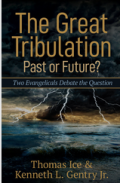
Debate book on the nature and timing of the great tribulation. Both sides thoroughly cover the evidence they deem necessary, then interact with each other.
See more study materials at: www.KennethGentry.com
But this is not an either/or situation. The Land Beast is acting both religiously and for public relations purposes. He is engaging in (what has by this time become) false religious worship in order to maintain influence among men. This is precisely like the religious leaders during and after Christ’s ministry. Instead of engaging worship to serve God, those who betray the Messiah act religiously but hypocritically, in loudly praying on street corners (Mt 6:5), engaging in showy religious fasts (Mt 6:16), doing various religious works, and wearing extravagant religious attire (Mt 23:5). They do this so as to be “noticed by men” and so that they could receive “honor at banquets, and the chief seats in the synagogues” (Mt 23:5).
After Christ’s death and the rending of the temple veil, the temple authorities continue sacrificing at the temple altar. Because of this the Land Beast “deceives those who dwell on the earth” (“in the Land”; 13:14). That is, Israel is (falsely) comforted to think “all is well” with our worship and our temple — just as if miraculous fire were falling from heaven as in the days of Aaron, David and Solomon. Deception is Satan’s work (12:9; 20:3); he blinds the eyes of men (2Co 4:4), and particularly those in Israel (2:9; 3:9; cp. Mt 13:13-16). And remember: this Land Beast “spoke as a dragon” (13:11), i.e., as Satan himself, deceptively (Jn 8:44).
In doing this, Israel’s religious authorities are following their rebellious OT fathers who trusted in ritual and not in God (Isa 1:10-17; Jer 7:1-6, 21-22; Hos 6:5-6; Mic 6:1-8; Mal 1:10). The author of Hebrews repeatedly makes this point (e.g., Heb 3:9-12; 4:1-8; 8:6-9; 12:25). The temple worship is now all for men, and not for God. This is so because God has turned from it to establish a new temple. We see this clearly in the conclusion to John’s drama: “I saw no temple in it, for the Lord God, the Almighty, and the Lamb, are its temple” (Rev 21:22).
[image error]For more information and to order click here.
" data-image-caption="" data-medium-file="https://postmillennialismtoday.files...." data-large-file="https://postmillennialismtoday.files...." class="alignright size-full wp-image-209" src="https://postmillennialismtoday.files...." alt="Navigating the Book of Revelation: Special Studies on Important Issues" />Navigating the Book of Revelation (by Ken Gentry)
Technical studies on key issues in Revelation, including the seven-sealed scroll, the cast out temple, Jewish persecution of Christianity, the Babylonian Harlot, and more.
See more study materials at: www.KennethGentry.com
The temple system that stood until AD 70 was “obsolete” (pepalaiōken) in John’s day and “ready to disappear” (Heb 8:13). The physical temple and its ritual service have become Israel’s idol. They themselves sold out their temple to Rome when they rejected the true temple, Christ (cf. Mk 14:58//; 15:29//). They declare in Jn 19:15: “We have no king but Caesar.” This declaration “was a clear renunciation of their Messianic hope, a virtual abolition of the Theocracy — a deliberate abandonment of their place and purpose as a nation” (Thomas Whitelaw, Commentary on John, 397). The temple service and religious rituals were deceptions. They no longer functioned under God’s blessing (13:14; cp. Gal 4:10; 5:6, 12; Php 3:2-3; Heb 9-10). The Land Beast’s deceiving activity entails his operating within Israel, for his “imagery and background suggest deception within the covenant community itself” (Beale, Revelation, 708).
September 27, 2022
THE LAND BEAST & GREAT SIGNS (1)
 PMW 2022-073 by Kenneth L. Gentry, Jr.
PMW 2022-073 by Kenneth L. Gentry, Jr.
In Rev 13:11 we see a beast “coming up out of the earth” in order to serve the beast from the sea (which is Rome). I argue that we might better translate the beast from “the earth” as the beast from “the Land,” i.e., the Promised Land, Israel. Specifically I hold that this Land Beast refers to the high-priestly aristocracy of Israel (as I have argued elsewhere).
But in Rev 13:13 we read of a remarkable action of the Land Beast: “He performs great signs, so that he even makes fire come down out of heaven to the earth in the presence of men” (Rev 13:13). What is going on here? How is this relevant to the first century high-priesthood?
We must always bear in mind that Rev is an extremely OT-oriented book. Indeed, it is the most Hebraic book in the NT. So when we look in the OT to see if we can find something to which John might be alluding, we discover a relevant, helpful source that had a direct relevance to the high-priesthood in Israel.
Three related OT episodes appear to be in John’s mind, each of which involves the formal worship of God and miraculous fire as a startling sign:
(1) We see it on the occasion in which Aaron establishes formal worship for Israel as he conducts his first offering as the high priest. On that grand occasion “fire came out from before the Lord and consumed the burnt offering” (Lev 9:24). Thus, Israel’s central altar was first fired by God himself, showing that God was pleased with the tabernacle and sacrificial worship.
THE APOCALYPSE OF JOHN[image error]
by Milton S. Terry
This book is Terry’s preterist commentary on the Book of Revelation. It was originally the last half of his much larger work, Biblical Apocalyptics. It is deeply-exegetical, tightly-argued, and clearly-presented.
For more study materials: www.kennethgentry.com
(2) We see miraculous fire again when God forgives David for his sin in numbering Israel. In 1Ch21:1 “Satan stood up against Israel and moved David to number Israel.” David sins in this, thereby bringing God’s wrath upon the people. So he builds an altar to seek the Lord’s forgiveness. The Lord responds by confirming his gracious forgiveness when he “answered him with fire from heaven on the altar” (1Ch 21:26).
(3) We see miraculous fire once again when Solomon dedicates Israel’s first permanent temple. During that worship dedication “fire came down from heaven and consumed the burnt offerings” (2Ch 7:1). Consequently, “when this Divine appearance was seen, the people supposed it to be a demonstration of God’s abode in the temple, and were pleased with it, and fell down upon the ground and worshipped” (Josephus, Ant. 8:4:4 §119).
Each of these dramatic episodes were confirmations that God was at work among his people when they worshiped him at the altar.
Therefore, these dramatic OT miracles powerfully affirm that the fire of the worship altar is God’s fire, a fire from heaven. This “fire from heaven = God’s fire” is true even in the non-miraculous, God-ordained altar fires that follow. These would be continuations of the fire that God himself started. In fact, in Rev itself we see that fire coming down from above derives from the altar — in heaven itself (8:3-5; 14:18).
So then, it appears that the Land Beast’s fire in the presence of the sea beast represents the Jewish high priesthood’s conducting temple sacrifices at the altar of God. And because John’s context involves the Land Beast’s submission to the sea beast (13:12–15), John has particularly in view the priestly sacrifices that first-century Israel offered in behalf of the Roman emperor.
THE BEAST OF REVELATION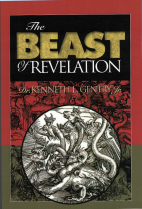
By Ken Gentry
A popularly written antidote to dispensational sensationalism and newspaper exegesis. Convincing biblical and historical evidence showing that the Beast was the Roman Emperor Nero Caesar, the first civil persecutor of the Church. The second half of the book shows Revelation’s date of writing, proving its composition as prior to the Fall of Jerusalem in A.D. 70. A thought-provoking treatment of a fascinating and confusing topic.
For more study materials, go to: www.kennethgentry.com
Therefore, in John’s drama the Land Beast is presented as mimicking godly altar-fire episodes. As the Jewish priests go about conducting temple worship, they operate as if their worship is from heaven itself from whence the first fire of God fell. The fire on “the altar of burnt-offering, shows that, while that fire might symbolise the presence of a holy Jehovah in His house, it could not refer to the fire of wrath or of punishment” (Edersheim, The Temple: Its Ministry and Services, 118).
But there is more. I will deal with that in my next article. Stay tuned.
September 23, 2022
KEY PRETERIST PRINCIPLES
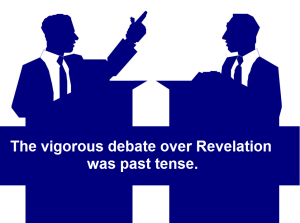 PMW 2022-072 by Kenneth L. Gentry, Jr.
PMW 2022-072 by Kenneth L. Gentry, Jr.
Modern postmillennialism is largely, though not solely, committed to a particular interpretive tool known as “preterism.” This tool is helpful for explaining many of the catastrophic judgment passages as features of the founding of Christianity in the first century rather than evidence for the decline of Christianity in the final century.
However, postmillennialists do not adopt this interpretive approach in order to avoid a negative impact on their eschatological system. Rather, preterism arises naturally from a careful reading of the biblical text.
The evangelical, Reformed preterist strongly holds to the futurity of the Second Advent, the resurrection, and the great judgment. These are orthodox givens well exhibited in Scripture and long held by historic Christianity in creedal form.
Three factors generate preterism: (1) the importance of chronological indicators in biblical prophecy, (2) the impact of OT apocalyptic language on eschatological discourse, and (3) the significance of A.D. 70 for redemptive history. Let us see how these impact Revelation.

The Book of Revelation Made Easy
(by Ken Gentry)
Helpful introduction to Revelation presenting keys for interpreting. Also provides studies of basic issues in Revelation’s story-line.|
See more study materials at: www.KennethGentry.com
First, chronological indicators
Preterism relies heavily upon Revelation’s assertions of the nearness of certain prophetic events (1:1,3; 22:6,10), while non-preterists disingenuously re-interpret these. When the preterist comes upon didactically-seated temporal delimiters, he allows them their literal significance and seeks an historical fulfillment in antiquity. Where absent, then other issues must suggest the proper interpretation, which may or may not demand a past fulfillment.
Second, symbolic imagery
The preterist recognizes the hyperbolic-symbolic nature of the dramatic visual imagery in apocalyptically-framed prophecies. Although most evangelicals recognize the symbolic character of OT apocalyptic, its influence in NT passages is often overlooked. This symbolism comes to its most far-reaching effect in the book of Revelation, which opens with a notice about it:
Rev. 1:1 “The Revelation of Jesus Christ, which God gave Him to show to His bond-servants, the things which must soon take place; and He sent and communicated it by His angel to His bond-servant John.”
The word translated “communicated” is the Greek verb semaino which means “to signify, symbolize.” It is used here in the context with deikenumi which is translated “to show.” Together they indicate the symbolic nature of “the Revelation of Jesus Christ” (Rev. 1:1a). This fact is immediately, illustrated when the first vision therein is explained as symbolism. The vision of Christ walking among the lampstands with seven stars in his hand (Rev. 1:9–16) is interpreted by him to show that literal lampstands and stars are not the point. Rather they symbolize the seven churches and the “angels” (messengers) of those churches (Rev. 1:20).
Tongues-speaking: Meaning, Purpose, and Cessation
 by Ken Gentry
by Ken Gentry
The position presented within is that tongues-speaking allowed the gift person to speak in a known human language without previously knowing it; tongues brought inspired revelation from God; the gift was a sign confirming the apostolic witness and warning of the coming destruction of Jerusalem; and therefore the gift ceased in the first century.
See more study materials at: www.KennethGentry.com
Third, new covenant Christianity
Preterists hold that the birth of new covenant Christianity at Pentecost (A.D. 30) necessarily leads to the death of old covenant Judaism in the holocaust (A.D. 70). According to Acts 2:16-21,40, tongues were a sign of the “blood and fire to envelop Jerusalem in A.D. 70.” For rejecting her prophesied Messiah (Lk 23:18-32; Mt 21:33-46; cp. 1Th 2:14-16), God judges Israel’s people, land, city, and temple (Mt 23:34-24:34). This judgment concludes for all times the typological-ceremonial era of the OT (Heb 8:13; cp. Jn 4:21; Heb 10:23-25; 12:18-29), which narrowly focused on one people (Dt 7:6; Ps 147:19-20; Am 3:2) in a confined land (Gen. 15:18; Psa. 135:10-12). This dramatically opens God’s redemption to all peoples in all the world (Mt 8: 10-11; 24:29-30; 28:18-20; Lk 24:44-49; Ac 1:8).
September 20, 2022
ENORMOUS LIFE-SPANS IN GENESIS 5
 PMW 2022-071 by Kenneth L. Gentry, Jr.
PMW 2022-071 by Kenneth L. Gentry, Jr.
The early generations of men following Adam live to enormous ages of centuries. According to the genealogy in Gen. 5 Adam lived to be 930; Seth 912; Enosh 905; Kenan 910; Mahalalel 895; Jered 962; Methusaleh 969; Lamech 777; Noah 950.
Then in the Gen. 11 genealogy after the Flood, longevity begins dropping: Shem lives to be 600; Arpachshad 438; Shelah 433; Eber 464; Peleg 239; Reu 239; Serug 230; Naho 148; Terah 205. Later Abraham lives to be 175 (Gen. 25:7) and Moses 120 (Deut. 34:7). Moses’ age was remarkable in its day (Deut. 34:7), and he even declared that a strong man might live to be 80 (Psa. 90:10).
Critical scholars point to these as evidence of Genesis’ mythological character. But these ages are set in a strongly historical context. Some well-meaning scholars suggest that the “years” in view are much shorter than our year. But the Gen. 5 chronology will not allow that, while the later genealogy in Gen. 11 obviously assumes standard year lengths as it points to declining longevity.

Postmillennialism
By Keith Mathison
The promises of the gospel offer hope of a brighter future for the families and nations of the earth. Mathison’s an optimistic eschatology supported by biblical, historical, and theological considerations.
See more study materials at: www.KennethGentry.com
These are literal ages from a remarkable era of history following the original creation. Three factors are apparently involved in allowing these life spans.
First, God intended for man to subdue the earth (Gen. 1:28) and wanted him to spread out through the world (cp. Gen. 11:8). Therefore, he allowed longer ages for earlier men to enhance population growth and geographical spreading.
Second, this probably also results from what scientists’ would call “natural causes.” Adam and Ever were originally created perfect and without any genetic defects. But as time went on, defects began multiplying and reducing longevity.
Third, apparently the climate changed after the Flood for we also see smaller animals and larger plants when compared to some of the large dinosaurs of the past.
AS IT IS WRITTEN: THE GENESIS ACCOUNT LITERAL OR LITERARY?
by Ken Gentry
Presents the exegetical evidence for Six-day Creation and against the Framework Hypothesis. Strong presentation and rebuttal to the Framework Hypothesis, while demonstrating and defending the Six-day Creation interpretation.
See more studies at: www.KennethGentry.com
Apparently, long lives are expected to return as the gospel conquers the world bringing in righteousness on a remarkable level. God tells Isaiah of this day:
“No longer will there be in it an infant who lives but a few days, Or an old man who does not live out his days; For the youth will die at the age of one hundred And the one who does not reach the age of one hundred Will be thought accursed. (Isa. 65:20)
In the height of the postmillennial advance of Christ’s kingdom, men will turn from their evil and destructive conduct, wars will decline and cease as peace takes root, medical research will expand without the encumbrance of evolutionary mythology, and God will pour out his covenantal blessings.
September 16, 2022
GOD’S WILL AND MAN’S GENDER
 PMW 2022-070 by Kenneth L. Gentry, Jr.
PMW 2022-070 by Kenneth L. Gentry, Jr.
In my last article I introduced the problem of cultural collapse as indicated by the transgender phenomenon as a social and political movement. In this article I will briefly highlight the biblical argument against transgender ideology. In that postmillennialism is biblically-rooted eschatological system which seeks a God’s-law governed moral system, postmillennialists need to understand the issues. So now let us consider transgenderism and:
The Divine Prohibition
For Christians the most important observations on trans-gender issues, though, come from God’s Word itself. Scripture speaks expressly against transgender behavior. It presents it as a sin that cries out for release through redemption and counseling.
Transgenderism is prohibited by creation design. As already noted, transgender conduct is contrary to the God-ordained order from the very beginning of creation. Genesis 1:27 states: “God created man in His own image, in the image of God He created him; male and female He created them.”
Transgenderism is prohibited by God’s Law. Divine laws established against homosexual conduct naturally include transgender activities. Leviticus 18:22 is clear: “You shall not lie with a male as one lies with a female; it is an abomination.”

Covenantal Theonomy
(by Ken Gentry)
A defense of theonomic ethics against a leading Reformed critic. Engages many of the leading objections to theonomy.
See more study materials at: www.KennethGentry.com
And this law continues in the New Testament where we read Paul’s statement regarding the gospel and sound doctrine: “We know that the Law is good, if one uses it lawfully, realizing the fact that law is not made for a righteous person, but for those who are lawless and rebellious, for the ungodly and sinners, for the unholy and profane, for those who kill their fathers or mothers, for murderers and immoral men and homosexuals and kidnappers and liars and perjurers, and whatever else is contrary to sound teaching, according to the glorious gospel of the blessed God, with which I have been entrusted” (1 Timothy 1:8–11).
Transgenderism is prohibited by biblical morality. In Deuteronomy 22:5 Moses states: “A woman shall not wear man’s clothing, nor shall a man put on a woman’s clothing; for whoever does these things is an abomination to the LORD your God.” This is not a fashion statement. It does not condemn women wearing jeans. This is a moral statement. It prohibits passing off one oneself as the opposite gender.
We see this moral requirement reappearing in the New Testament. In 1 Corinthians 11:14–15 Paul state: “Does not even nature itself teach you that if a man has long hair, it is a dishonor to him, but if a woman has long hair, it is a glory to her? For her hair is given to her for a covering.” By “nature” here, Paul means social mores, cultural expectations. This is obviously the case in that nature does allow male and female hair to grow long.
Paul is pressing the moral values of Deuteronomy 22:5 regarding social conduct and decorum. Long hair conveyed sexual ambiguity and moral perversion. In antiquity it was worn by male transgenders and homosexual prostitutes. For instance, Epictetus (d. 135) commented: “Are you a man or woman? We ought not to confuse the sexes which have been distinguished in this fashion.” The first-century Jewish philosopher Philo warned of “the disease of effemination” (Special Laws 3:7:37–38).
Transgenderism is prohibited by divine warning. In 1 Corinthians 6:9–10 Paul states: “Do you not know that the unrighteous will not inherit the kingdom of God? Do not be deceived; neither fornicators, nor idolaters, nor adulterers, nor effeminate, nor homosexuals, nor thieves, nor the covetous, nor drunkards, nor revilers, nor swindlers, will inherit the kingdom of God.” The word “effiminate” is a translation of the Greek word malakoi which means “soft men.” That is, men desiring femininity.
The Biblical Counsel
How shall Christians argue the biblical case against transgenderism? How can we counsel transgenders and homosexuals who claim to be Christian — even while they freely engage in this conduct?
Point them to the teaching of the Bible. The Bible is clear. And the true Christian will accept it as God’s Word. We should not let them waffle with a “Yes, but….” This of course will require that Christians know their Bibles.
Warn them not to claim they were “born that way.” Modern thought claims most reprehensible sins are genetically-determined. Medical scientists today are beginning to declare that pedophiles are born that way. Shall pedophilia be tolerated on this basis? And think of violent crime. Ninety percent of violent crimes are committed by men. And this is influenced by testosterone. Shall we allow violence since men are “born that way”?
Urge them to live by the Bible. In all of life. Remind them that John warns: “If we say that we have fellowship with Him and yet walk in the darkness, we lie and do not practice the truth.” Jesus present God’s Word as a sanctifying influence. In John 17:17 he prays: “sanctify them in the truth; Your word is truth.”
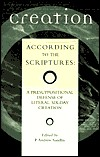 Creation according to the Scriptures
Creation according to the Scriptures
Ed. by P. Andrew Sandlin
This book is sub-titled: A Presuppositional Defense of Literal , Six-day Creation. It has chapters by R. J. Rushdoony, Andrew Sandlin, Kenneth Gentry, Cornelius Van Til, and others. It touches on historical, exegetical, theological, and philosophical implications of Six-day Creation.
See more study materials at: www.KennethGentry.com
Life can be difficult, to be sure. Paul struggled with covetousness. But he did struggle against it; he did not give in and pursue his covetous desires (Rom. 7:21–25).
Promise them hope in true redemption. Paul pointed out the power of the gospel to claim homosexuals and transgenders. To the Corinthians he wrote: “Do you not know that the unrighteous will not inherit the kingdom of God? Do not be deceived; neither fornicators, nor idolaters, nor adulterers, nor effeminate, nor homosexuals…. Such were some of you; but you were washed, but you were sanctified, but you were justified in the name of the Lord Jesus Christ and in the Spirit of our God” (1 Cor. 6:9, 11).
America needs a true Christian revival. The church needs a fundamental Reformation. Let’s pray God grants both. Soon. Otherwise our hope must await the next generation.
Click on the following images for more information on these studies:
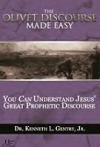

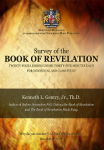
September 13, 2022
GENDER CONFUSION & POSTMILLENNIALISM
 PMW 2022-069 by Kenneth L. Gentry, Jr., Th.D.
PMW 2022-069 by Kenneth L. Gentry, Jr., Th.D.
The postmillennial hope is rooted in God’s word, not man’s world. Postmillennialism expects ups-and-downs as history unfolds. Though eventually the advances will far outweigh the declines. However, currently we are witnessing a downward trend in our cultural situation.
Our culture is now in such a state of rebellion against God that it cannot even tell the difference between male and female, such is the blindness of unbelief. The postmillennial hope involves a deep and abiding commitment to God’s word and his law to shine a light on our path forward. Unfortunately, so many Christian churches have become so invested in fun and entertainment instead of worship and study that Christians are confused in how to respond to our collapsing culture.
In this article I will focus on one of the most remarkable moral errors of our day: the affirmation of transgender ideology. We must understand its error in order to critique it, rebut it, and move beyond it.
Gender Identity is the latest rage among postmodernists. Especially since the June 2015 transformation of Bruce Jenner from a male to the female Caitlyn Jenner, transgender discussions have exploded on the scene. And many Christian leaders and laymen have gotten on the politically-correct bandwagon. But what does the Bible have to say about this phenomenon? Much, in every way.
The Creation Expectation
In Genesis 1:27 we read: “God created man in His own image, in the image of God He created him; male and female He created them.” This statement most clearly presents God’s creation design for the human race. He established gender as a binary distinction within mankind. He established them as two distinct kinds.
The word “gender” is derived from the Latin genus, which means “kind, type.” Thus, God established two kinds of people: male and female. And then he declared this (and all else that came from his creative activity): “very good” (Gen. 1:31).

As It Is Written: The Genesis Account Literal or Literary?
Book by Ken Gentry
Presents the exegetical evidence for Six-day Creation and against the Framework Hypothesis.
See more study materials at: www.KennethGentry.com
This truth is re-iterated later in summarizing man’s creation. Moses introduces the first genealogy in Scripture, which traces Adam’s multiplying in the earth (per God’s command, Gen 1:28). And there we once again hear his declaration: “He created them male and female, and He blessed them and named them Man in the day when they were created” (Gen . 5:2). Then follows the genealogy of the early human race from Adam to Noah.
We must recognize that this genealogical development is essential to redemption. For this genealogy begins unfolding throughout the Old Testament, reaching into the New, leading to the birth of Jesus. His birth would have been impossible on either a homosexual or transgender principle, for birth requires opposite genders. The whole story of redemption requires a seed, and in the God-created order, seed requires gender distinctions.
Jesus himself confirms this original creation order when he declares: “from the beginning of creation, God made them male and female” (Mark 10:6).
Gender identity is a part of the creation order and lends itself to a strong creation theology which arises from Genesis 1–2. The further we depart from God’s creation design, the worse things will go for us. Man cannot shake his fist in the face of God with impunity. In this regard we should remember God’s rebuke of Job. God issues a thundering challenge to his stumbling servant: “Then the LORD said to Job, ‘Will the faultfinder contend with the Almighty? Let him who reproves God answer it’” (Job 40:1–2).
We live in a God-designed and God-created world under God-appointed laws. Rejecting the divine order can only lead to our peril.
Our Current Predicament
Sin complicates matters; life is not simple with sin present Sin disrupts all of life’s activities, causing broken marriages, crime, war, and more. And today sin is even complicating the most basic identity of man as male and female.
Until fairly recently, all agreed there were two genders. And if you check any obstetrics ward you will find two genders represented there. But sin elevates the subjective over the objective, desire over reality. And the Bible calls this elevation: lust.
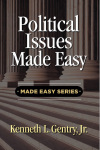 Political Issues Made Easy
Political Issues Made Easy
by Kenneth Gentry
Christian principles applied to practical political issues, including the importance of borders, the biblical warrant for “lesser-of-evils” voting, and more. A manual to help establish a fundamentally biblical approach to politics. Impressively thorough yet concise.
See more study materials at: www.KennethGentry.com
Genesis 1 speaks of two objective, actual, God-ordained genders. But recent, avant-garde psychology does not. We are now hearing that gender identity is a subjective experience. The American Psychological Association defines the matter thus: “Gender identity is a person’s private sense and subjective experience of their own gender. Gender identity refers to a person’s internal sense of being male, female or something else.” It continues by noting that gender “expression refers to the way a person communicates gender identity to others through behavior, clothing, hairstyles, voice or body characteristics.” (http://www.apa.org/topics/lgbt/transgender.aspx)
In 1984 Dr. N. W. Fisk was the first professional to diagnose “Gender Dysphoria.” The word “dysphoria” is based on two Greek words: dus (“difficult”) and pherein (“to bear). “Gender dysphoria” is one’s unhappiness, unease, or dissatisfaction with his or her biological sex, which makes one’s personal life “difficult to bear.”
Previous to our times, one’s sexual identity and role was understood to be one of two particular, non-overlapping characteristics: male or female. But today, the increasing rejection of God and morality has encouraged sin’s integration downward into the void. As sin “gets its act together,” it moves more rapidly into destruction. Tragically, many today are arguing for multiple genders, and unlimited blended continuum.
This recent approach to gender is not simply a bizarre annoyance. It cannot be written off as a sad situation. It is impacting society, especially in education and law — with enormous cultural consequences. As our nation moves further and more rapidly away from God, things will trend more quickly from bad to worse.
We see gender corruption in education. Our northern neighbor Canada has progressed further down this path than we have. The British Columbia Teachers Federation’s Handbook on Gender Education, notes that “Gender is a product of the mind…. Being transgender or gender-non-conforming is normal and healthy.” It warns of “outdated and oppressive views of gender-continuity that circulate in our everyday understanding of what it means to be human.”
And how does this Handbook recommend guarding against oppressive (God-ordained) views? It recommends “access to safe restroom and locker room facilities that correspond to one’s gender identity.”
But American liberal educational theorists are not to be outdone. Redwood Heights Elementary School in Oakland, California, has appointed “gender coaches” to teach young children that “you can be a boy or a girl, or both.” In fact, the United States National Education Association president recently stated at a national convention: “comprehensive sex education is the only way to combat heterosexism and gender conformity. We must make these issues a part of every middle and high school student’s agenda. Gender identity express and sexual orientation is a spectrum. And those opposed to homosexuality are stuck in a binary box that religion and family create.”
We see gender corruption in law. A January 2014 California law “guarantees students in K-12 the right to use the school restrooms and to participate in the sex-segregated activities that correspond with their expressed genders instead of their school records.”
Such laws exist in Massachusetts and Connecticut. And they even go further. According to the February 25, 2014 Huffington Post: “Some school districts take the law as a mandate to evaluate sleeping arrangements for overnight field trips and activities such as choirs and recreational sports where girls and boys are often separated.”
A slightly earlier Huffington Post article (January 31, 2014) stated: “School officials violated state anti-discrimination law when they would not allow a transgender fifth-grader to use the girls’ bathroom, according to a ruling by the highest court in Maine.”
In Maryland a similar 2014 law was rightly complained against. According MSNBC: House Minority whip Kathy Szeliga sated: “We should be very concerned about the safety of women and little girls, because what this allows is that possible predators and pedophiles can go in our women’s restrooms.”
We hear much today about school bullies. And bullying is a sad situation. But how is the law responding to this social problem? What are they recommending? And who is pushing anti-bullying laws?
A June 4, 2011, WND article noted that “The anti-bullying bills being passed in haste across the country force a range of draconian fixes on public schools. The main force (and funding) behind this national push has been the homosexual and transgender movements.”
A CBN News release on May 24, 2012, reported that Illinois state senator Kyle McCarter helped stop a bill in 2012. McCarter warned that “there are anti-bullying programs that have an agenda: to only protect one class of individuals. Some of these programs are very good. They indeed encourage kids not to bully. But there are program throughout the United States, used in some high schools and universities, that really have just a pro-homosexual agenda, and nothing but that.”
But now what does God’s word teach us about the matter? That is the question to be settled in my next article.
Click on the following images for more information on these studies:



September 9, 2022
REVELATION & THE EARTH DWELLERS (4)
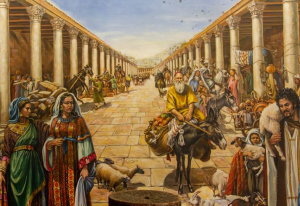 PMW 2022-068 by Kenneth L. Gentry, Jr.
PMW 2022-068 by Kenneth L. Gentry, Jr.
This is the fourth and final article in a series exploring the meaning of “those who dwell on the earth” in Revelation. I am arguing that “earth” should be translated “Land” (i.e., of Israel), and that the phrase refers to the Jews in Israel. So let’s continue!
We find the second clear reference in our text in 6:10. Here we read: “They cried out with a loud voice, saying, ‘How long, O Lord, holy and true, will You refrain from judging and avenging our blood on those who dwell on the earth [tōn katoikountōn epi tēs gēs]?’” (6:10). That the Land-dweller phrase clearly applies to Jews in Israel appears on the following evidence.
(1) In the NT the only other phraseology outside of Rev that is similar to this appears in Lk 21:35 which bears “striking similarities” (Penley 90; cp. 105ff) to Rev 6:10 and which applies to Israel in AD 70. There we read of judgment that will suddenly come: “for it will come upon all those who dwell on the face of all the earth.” As I argue in the Introduction to this commentary, John’s drama is a revelation from Jesus Christ (1:1) and draws frequently from Jesus’ teaching. In fact, the seals specifically follow the pattern of his Olivet Discourse and Lk 21:35 appears in Luke’s version of that Discourse. There in Luke the phrase is expanded: epi pantas tous kathēmenous epi prosōpon pasēs tēs gēs. The major translations give a universalistic reading along the lines of the NASB: “all those who dwell on the face of all the earth.” The translators are mistaken, for Luke 21 is dealing with God’s judgment on Israel. As evidence I would offer the following:
Four Views on the Book of Revelation
(ed. by Marvin Pate)
Helpful presentation of four approaches to Revelation. Ken Gentry writes the chapter on the preterist approach to Revelation, which provides a 50 page survey of Revelation .
See more study materials at: www.KennethGentry.com
(a) The Lord’s eschatological discourse arises from his announcing the temple’s approaching doom (Lk 21:5–6). (b) He expressly warns his disciples of the desolation coming upon Jerusalem (v 20), the need to flee from Judea (v 21), and the Gentile trampling of the holy city (v 24). Within this five verse section (Lk 21:20–24) — which clearly emphasizes Jerusalem’s destruction — appears his first mention of “the land” and its people: “there will be great distress upon the land, and wrath to this people” (anagkē megalē eip tēs hēs kai orgē tō laō toutō). Most commentators recognize this as referring to Israel. Thus, what we have here is “Luke’s first use of tēs gēs in the eschatological discourse sets a precedent that is taken up again in Lk. 21.35” (Penley 100). (d) Immediately after Jerusalem’s destruction (vv 20–24) Jesus mentions cosmic signs that cause dismay among the nations, which is language that is applied to Israel’s judgment in the OT. We see this in Jer 4:27–28 (=Israel, vv 14, 16, 20, 22) and Joel 2:10 (=Israel, vv 1 [hoi katoikountes tēn gēn], 12–13, 15–18). Thus, in these OT references, as in Lk 21, God’s localized judgment reverberates throughout the earth (see the clear example of Egypt’s judgment causing dismay among many nations, Eze 32:7–10). (e) In Lk 21 Jesus repeatedly warns of the nearness of the judgment (which we know relates to AD 70, vv 20–24). The word “near” (engus / eggizei) appears in vv 28b, 30, 31b, as well as the statement “this generation will not pass away until all things take place” (v 32).
(2) John’s record of the cry of the martyrs also strongly reflects the sentiment (at least) of Jesus’ statement (though having only a small lexical correspondence) that is uttered just before the Olivet Discourse. In 6:10 we read their cry for God’s “judging and avenging our blood [haima] on those who dwell “on the earth” (epi tēs gēs). In Mt 23:35 he warns Jerusalem: “upon you may fall the guilt of all the righteous blood [haima] shed on earth [epi tēs gēs].” The martyr’s cry for God’s judgment against who shed their blood corresponds with Jesus’ warning to the Pharisees and religious rulers of Israel (Mt 23:2, 29). I would note also that the context of both statements includes the idea of filling up the proper number of martyrs: “You are the sons of those who murdered the prophets. Fill up, then, the measure” (Mt 23:31–32) / “rest for a little while longer, until the number of their fellow servants . . . would be completed” (Rev 6:11). They also involve the nearness of God’s wrath: “all these things will come upon this generation” (Mt 23:36) / “rest for a little while longer, until” (Rev 6:11). In Exc 8 (at 6:11) below I will provide abundant evidence that first-century Jews did severely persecute Christians.

Keys to the Book of Revelation
(DVDs by Ken Gentry)
Provides the necessary keys for opening Revelation to a deeper and clearer understanding.
See more study materials at: www.KennethGentry.com
(3) As just noted, the seal judgment in 6:11 urges them to rest only “for a little while longer” (Rev 6:11). This requires that their vindication through God’s judgment upon their enemies (“the Land-dwellers”) would be soon. This matches well with AD 70 and the argument that these are indeed dwellers in the Promised Land of Israel. John wrote his great prophetic work almost 2000 years ago.
(4) I would also note that immediately following the fifth seal, the sixth one speaks of “the kings of the earth” (6:15). I show in the Exc 2 (at 1:5) that this seems to be John’s imagery for the religious rulers of Israel, as kings of the “Land.” This fulfills (at least in part) the promised judgment against Land-dwellers in the preceding seal judgment. John associates the Land-dwellers with the “kings of the Land’ once again in 17:2. And just as the blood of the martyrs deserves vindication against the Land-dwellers in 6:10, so the “kings of the earth” in 17:2 are “drunk with the wine of her [Babylon-Jerusalem’s] immorality which involves being “drunk with the blood of the saints, and with the blood of the witnesses of Jesus” (17:6).
Our final two clear references appear in 11:10: “those who dwell on the earth will rejoice over them and celebrate; and they will send gifts to one another, because these two prophets tormented those who dwell on the earth.”
As Charles (1:289–90) argues, the Land-dwellers in 11:10 necessarily refers to “the inhabitants of Palestine” because the events there occur in Jerusalem (11:1–2, 8). On p. 289 he further notes regarding our phrase here (the only place in Rev where he interprets it thus): “It is hard to see what the inhabitants of the earth would have to do with the two prophets who appear in Jerusalem in the struggle against the Beast from the abyss. And besides, when the Witnesses fell, the inhabitants could within three and a half days hear of their death, rejoice and send presents to each other; but this could not be possible if the phrase were taken to mean the inhabitants of the earth.” He continues (289–90): “the phrase meant the inhabitants of Palestine, and there is no convincing ground for assigning a different meaning to it.”
This whole setting in Rev 11 fits perfectly with John’s Israel-judgment theme (1:7). And it strongly underscores the meaning of the Land-dwellers as representing the Jews in the Land of Israel.. As I will demonstrate in the commentary at the proper place, this chapter opens with a reference to the coming destruction of the temple in 11:1–2 which is strongly modeled on Lk 21:24 as found in the Olivet Discourse. Then it moves on to relate the deaths of the two mysterious prophets who are slain in the street of Jerusalem (11:8) which causes the Land-dwellers to rejoice (11:10).
Second, the very likely allusions. Like 3:10 (a clear allusion) both 13:7–8 and 14:6 set “every nation and tribe and tongue and people” over against the “land dwellers.” These verses probably continue the pattern of synthetic parallelism established in 3:10. Rev’s main theme is God’s judgment upon Israel (1:7) but it places Israel’s situation squarely within the wider Roman imperial setting. Not only so but, the Land-dwellers are set in theological contrast to those who “dwell in heaven” at 13:6, just as are the Jews (or Jerusalem) in Gal 4:25 and Heb 12:22. (And just as the earthly altar and temple are set in opposition to the heavenly altar and temple.) The Jewish interest in the Land and the externals of religious devotion are well known. Thus, the first-century Jews are particularly interested in a Messiah who would free their Land from Roman rule (Jn 6:15; Lk 24:21). Rev will be showing an “exodus” out of the Land though. By his synthetic parallelism John is theologically condemning them for their fixation upon earthly things.
Third, the quite possible allusions. In 17:2 we see the Land-dwellers linked with the “kings of the earth [Land]” as in 6:10–11. This linkage suggests their possible relationship as people (Land-dwellers) to their rulers (kings of the Land, the Jewish religious leaders). If this linkage holds (and I believe it does), then it would draw in with it the Land-dwellers in 17:8.
Fourth, uncertain allusions. The remaining examples of the Land-dwellers are found in 8:13 and 13:12, 14 [2x]. Their contextual settings are not clear on the surface, though I believe that a proper interpretation of those contexts well support their uniform identification along with the others.
Conclusion
As I show above, and as I will show even more in comments on each of the relevant passages, John uses the Land-dweller phrase in speaking of the non-Christian Jews in Palestine. This term is used in a derogatory way to expose Israel’s vehement opposition to Christ and his people.
Click on the following images for more information on these studies:

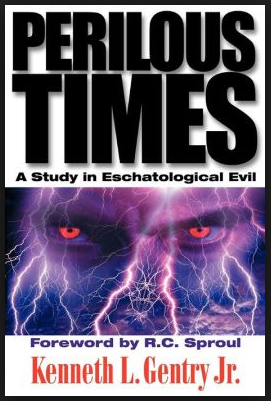
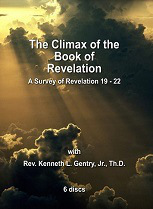
September 6, 2022
REVELATION & THE EARTH DWELLERS (3)
 PMW 2022-067 by Kenneth L. Gentry, Jr.
PMW 2022-067 by Kenneth L. Gentry, Jr.
In Revelation we have an interesting phrase that occurs time and again, and which plays an important role in John’s apocalyptic drama. This is the third in a four-part series analyzing the phrase and its significance for the redemptive-historical preterist view of Revelation that I hold.
So, now let’s continue by considering the issue in Revelation itself, as we look at:
The “Land-dwellers” in Revelation
Of the twelve appearances of gē linked with katoikia, four of them quite clearly refer to the Jews in the Land of Israel (3:10; 6:10; 11:10 [2x]), two of them (13:7–8 and 14:6) seem strongly to refer to Israel, and two (17:2, 8) could very well do so. The remaining four references could go either way, but in light of the clearer allusions and John’s using the phrase as a recurring technical designation, they surely designate the same people.
First, the clear allusions. The first clear reference is 3:10. This verse not only offers clear evidence toward the Jew-focused interpretation, but happens to be John’s first use of this recurring technical phrase. It will be helpful to present the phrase in its context:
“And to the angel of the church in Philadelphia write: He who is holy, who is true, who has the key of David, who opens and no one will shut, and who shuts and no one opens, says this: I know your deeds. Behold, I have put before you an open door which no one can shut, because you have a little power, and have kept My word, and have not denied My name. Behold, I will cause those of the synagogue of Satan, who say that they are Jews and are not, but lie — I will make them come and bow down at your feet, and make them know that I have loved you. Because you have kept the word of My perseverance, I also will keep you from the hour of testing, that hour which is about to come upon the whole world, to test those who dwell on the earth. I am coming quickly; hold fast what you have, so that no one will take your crown.” (3:7–10)
Charismatic Gift of Prophecy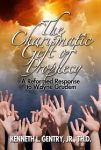
(by Kenneth Gentry)
A rebuttal to charismatic arguments for the gift of prophecy continuing in the church today. Demonstrates that all revelatory gifts have ceased as of the conclusion of the Apostolic era.
See more study materials at: www.KennethGentry.com
Besides all the previous argument regarding the use of gē in this highly Hebraic work, I would point out the following supporting evidence. I would introduce the evidence by nothing that this first use of Land-dwellers is set in what is inarguably the most Jewish of the seven oracles. In itself this opens up the strong likelihood that the phrase is itself a Jewish designation.
(1) This oracle opens with Christ’s Messianic declaration that he holds the “key of David” and that he alone can and open and shut the kingdom to men (3:7).
(2) This is one of two oracles that strongly denounces the Jews as composing a “synagogue of Satan” and being false Jews (3:9a; cp. 2:9).
(3) Immediately after this denunciation he promises that he will subjugate these Jews (3:9b) in such a way that they will know that he loves the Christian (3:9c).
(4) He sets the Land-dwellers over against “the whole world” in a synthetic parallelism: “I also will keep you from the hour of testing, that hour which is about to come upon the whole world, to test those who dwell on the earth” (3:10b, c). In this regard I would note that “the whole world” is a translation of oikoumenē holēs. This does not require a truly global conflagration. This is the only place in the NT where katoikountēs occurs with oikoumenē holēs. But oikoumenē often means simply the Roman empire, not the whole world and all seven continents. This is true of even global-sounding statements very similar to that in 3:10. For instance, in Mt 24 and Ac 11 we do discover very similar expressions (though lacking any reference to katoikountēs).
Four Views on the Book of Revelation
(ed. by Marvin Pate)
Helpful presentation of four approaches to Revelation. Ken Gentry writes the chapter on the preterist approach to Revelation, which provides a 50 page survey of Revelation .
See more study materials at: www.KennethGentry.com
In Mt 24:14 we learn that the gospel “shall be preaching in the whole world [en holē tē oikoumenē].” This speaks of the Roman empire as we can see by interpreting it in the light of Col 1:6, 23 (cp. Ro 1:8) and due to its near-term limitation (Mt 24:2, 34). In Ac 11:28b we read of Agabus’ prophecy of a coming “great famine all over the world [holēn tēn oikoumenēn].” The next words after this are: “and this took place in the reign of Claudius” (Ac 11:28c). Thus, Rev 3:10 is speaking of an empire-wide hour of testing (not a global testing) that will especially focus on the Land-dwellers. Furthermore, Land-dweller and “whole world” statements are not synonymous parallels repeating the same fact. Rather they are synthetic parallels with the second one adding to the first statement (Penley 113, 115). Indeed, though the world/Roman empire will be tested in the near future, the ultimate design of “the hour of testing” is to test those who dwell in the Land (as per Rev’s theme, 1:7).
(5) He expressly promises that this will all occur soon: it “is about to come” (3:10b) and it will come “quickly” (3:11a).
(6) All of this love of the saints and the judgment on the Land-dwellers (the false Jews of the synagogue of Satan) will result in the saints’ entry into the new Jerusalem in heaven above (3:12d, e).
(7) As noted previously the Land-dweller language derives from Hos 4:1 (LXX) which is (a) clearly directed against “the Sons of Israel” (Hos 4:1a) and (b) represents a legal “case [ribh] against the inhabitants of the land” (Hos 4:1b). This perfectly matches what is occurring in Rev, which is a forensic drama presenting God’s judgment against Israel.
In the fourth and final article I will consider the second point in this regard. Stay tuned.
September 2, 2022
REVELATION & THE EARTH DWELLERS (2)
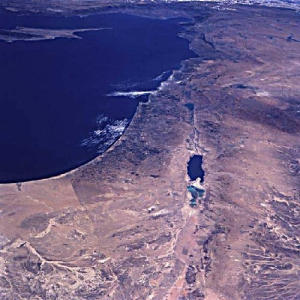 PMW 2022-066 by Kenneth L. Gentry, Jr.
PMW 2022-066 by Kenneth L. Gentry, Jr.
This is the second article in a four-part series on an important recurring phrase in Revelation, generally translated “those who dwell on the earth.” I am arguing that it should be translated “those who dwell in the Land,” i.e., of Israel. For brevity I translate the whole phrase as “Land-dwellers.” In this article I will begin with:
“The Land” in Revelation
Before discussing the Land in Rev I would remind the reader of Rev’s strongly Judaic character. As I argue in the Introduction (as per most commentators) Rev is wholly saturated with OT allusions, strongly expressed in terms of Hebraic syntactical peculiarities, and brightly colored by Judaic images. John also presents his work as a forensic drama wherein he is presenting a covenant lawsuit from God. All of this prepares us for recognizing the possible use of the Land as an important image in this remarkable work and the Land-dwellers as the recipients of most of its judgments.
In my last article I pointed out that in Rev the Greek hē gē most often refers to the Land of Israel rather than to the generic earth, though like the Hebrew term ‘eretz, it could go either way. In my commentary not yet published) I will provide a chart that sorts out the uses of hē gē in Rev, noting that 64% of them seem clearly to refer to the Land of Israel and 6% of them are uncertain. There I also argue that the recurring phrase “the kings of the earth” (tōn basileōn tēs gēs, Rev 1:5) refers to the religious rulers of the Land. I agree with Buchanan (118) that it is “obvious that the promised land is the central geographical unit in the Book of Revelation.”

As It Is Written: The Genesis Account Literal or Literary?
Book by Ken Gentry
Presents the exegetical evidence for Six-day Creation and against the Framework Hypothesis.
See more study materials at: www.KennethGentry.com
All of this opens the possibility of interpreting “those who dwell upon the earth” (tous katoikountas epi tēs gēs) and similar expressions as always denoting the Jews who live in the Promised Land. And as we shall see, John appears to draw his first appearance of Land-dwellers in 3:10 from Hos 4:1. This is significant in that it not only links the Land-dwellers to the OT but to a covenant lawsuit against Israel. But more on this later.
The “Land-dwellers” in the OT
As he comments on the first appearance of “Land-dwellers” in Rev 3:10, Hort (35; cp. Charles, 1:289; Thomas 1:289n) suggests that John derives this phrase from Hos 4:1 (LXX). Other commentators recognize its general OT backdrop (e.g., Swete 56; Aune 240). Hos 4:1 clearly speaks of rebellious Israel (though Hort applies 3:10 to the wider world): “Listen to the word of the LORD, O sons of Israel, / For the LORD has a case against the inhabitants of the land [tous katoikountas tēn gēn], / Because there is no faithfulness or kindness / Or knowledge of God in the land [epi tēs gēs].”
In the LXX, references to Israel as the Land-dwellers occur often, with the phrasing including epi (as generally in Rev) in Jer 1:15; 6:12; Eze 7:7; Zep 1:8; Zec 11:6 (though without epi in Hos 4:1a; Jer 10:18; Joel 1:2, 14; 2:1). The phrase frequently applies to idolatrous pagans — although specifically to those dwelling in the Land (Nu 32:17; 33:52, 55; Jos 7:9; 9:24; Jdg 1:32; 2Sa 5:6; 1Ch 11:4; 22:18). Buchanan (128) observes that “the great majority of cases, however, identify [the Hebrew phrase] as those who lived on the land of Palestine (Exod 23:31; 34:12, 15; Josh 2:9, 24; 6:12; 7:9; 9:14; 10:18; 13:21; 24:18; 25:29, 30; Judges 1:32–33; Ezek 7:7; Hos 4:1; Joel 1:2, 14; 2:1; Zech 11:6) and should be rendered ‘inhabitants of the land’ rather than ‘inhabitants of the earth.” Thus we see how the Land-dweller phrase speaks of people in the Land, i.e., the Promised Land.
Against those who would interpret this phrase broadly to cover people throughout the world, Penley (108) notes of the similar phraseology in the LXX: This combination “consistently refers to a specific land region in which a tribe or people group lives. . . . The land region could be as large as Canaan or as small as a single city” (Penley 108). In fact, he points out that twenty-two times these two words (gē and katoikia) also appear with the preposition epi (as in Rev and Lk 21:35 [see below]): Ge 47:27; Lev 18:3; 20:22; 25:10, 18, 19; 26:5; Num 13:32; 14:14; 33:55; 35:32, 34; Dt 2:20; 12:10; 17:14; 26:1; 30:20; Jos 9:24; 22:3; 24:15; 1Ki 8:27; 2Ch 6:18. Only one of these (Lev 18:3) applies to a place other than the Promised Land (but there it speaks of the Jews dwelling in Egypt).
The Book of Revelation Made Easy
(by Ken Gentry)
Helpful introduction to Revelation presenting keys for interpreting. Also provides studies of basic issues in Revelation’s story-line.|
See more study materials at: www.KennethGentry.com
The two references most similar to the Rev phrases are Nu 14:14 (pantes hoi katoikountes epi tēs gēs tautēs) and 33:55 (tous katoikountas epi tēs gēs) which refer to the people in Canaan before Israel conquers them. And when using the Hebrew texts containing the Hebrew form of the words: “the most common referent in the prophets is the inhabitants of the land of Israel not all the inhabitants of the earth” (Penley 109). See: La 4:12; Hos 4:1; Joel 1:2, 14; 2:1; Isa 9:1; 21:14; 24:6, 17; 26:21; Jer 1:14; 6:12; 10:18; 13:13; 25:29, 30; 38:11; Eze 7:7; Da 4:35; Zep 1:18; Zec 11:6.
Thus the OT source of this Land-dweller phrase most often speaks of the Promised Land and of the Jews who are its inhabitants. I believe that this is the way John employs the phrase.
In my next article I will focus on the “Land-dwellers” in Revelation (since I have advertised this in my article titles!).
August 30, 2022
REVELATION & THE EARTH DWELLERS (1)
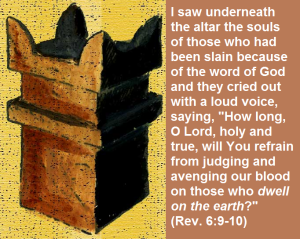 PMW 2022-065 by Kenneth L. Gentry, Jr.
PMW 2022-065 by Kenneth L. Gentry, Jr.
In Revelation we frequently read about “those who dwell upon the earth.” This is an important recurring phrase that serves as a terminus technicus for John. It occurs twelve times in seven closely related grammatical forms (3:10; 6:10; 8:13; 11:10 [2 x]; 13:8, 12, 14 [2x]; 14:6; 17:2, 8). The form we have at 6:10 is: tōn katoikountōn epi tēs gēs. Elsewhere we find the following:
tous katoikountas epi tēs gēs (3:10; 8:13; 11:10b; 13:14a)
hoi katoikountes epi tēs gēs (11:10a; 13:8; 17:8)
tois katoikousin epi tēs gēs (13:14b)
tēn gēn kai tous en autē katoikountas (13:12)
tous kathēmenous epi tēs gēs (14:6)
hoi katoikountes tēn gēn (17:2).
The variations are minor, due largely to case changes necessary for fitting them into their several contexts, though epi does not appear in 13:12 and 17:2.
The vast majority of commentators interpret this phrase as applying broadly to the human race in its opposition to God (Gill 711; Alford 586; Hort 35; Mounce 103, 148; Morris 79; Beale 290; Kistemaker 163; Harrington 71, Thomas 1:289; Keener 151; Smalley 92; Osborne 193; Resseguie 98–99; Boxall 73).
[image error]For more information and to order click here.
" data-image-caption="" data-medium-file="https://postmillennialismtoday.files...." data-large-file="https://postmillennialismtoday.files...." class="alignright size-full wp-image-209" src="https://postmillennialismtoday.files...." alt="Navigating the Book of Revelation: Special Studies on Important Issues" />Navigating the Book of Revelation (by Ken Gentry)
Technical studies on key issues in Revelation, including the seven-sealed scroll, the cast out temple, Jewish persecution of Christianity, the Babylonian Harlot, and more.
See more study materials at: www.KennethGentry.com
But we do find a number of able scholars who dispute this universal description. The following interpret the phrase as referring to those who live in the Land of Israel (some only in a passage or two, others more fully): Stuart (2:161, 236), Russell (1887: 394), Charles (1:289–90), Carrington (131, 157), Ford (180), Beagley (68), Chilton (282), Van De Water (245–61), Malina (61–62, 128, 147), Lupieri (159, 223), Penley (105–19), and Buchanan (111, 175). Interestingly, even the dispensationalist work Doomsday Delusions (Pate 1995: 49) argues regarding 6:10: “while the phrase can mean ‘the inhabitants of the world,’ the more likely meaning of the phrase in Revelation 6:10 is ‘the inhabitants of the land [Palestine].”
But how does this phrase function for John? Reflecting his OT backdrop, John takes up the prophetic mantel and like the prophets of old once again charges Israel with idolatry in the new covenant era. He effectively denounces the Jews basically as “unbelieving idolaters,” to use Beale’s phrase but in a different way. In John’s forensic drama this idolatry charge applies to the Jews whom he deems organized as a “synagogue of Satan” who only falsely claim to be true Jews (2:9; 3:9). Indeed, their holy city is designated “Sodom and Egypt” (11:8) — and “Babylon” (16:9; 17:5).
Before Jerusalem Fell
(by Ken Gentry)
Doctoral dissertation defending a pre-AD 70 date for Revelation’s writing. Thoroughly covers internal evidence from Revelation, external evidence from history, and objections to the early date by scholars.
See more study materials at: www.KennethGentry.com
Throughout his Gospel John shows that Jesus constantly calls upon Israel to believe (Jn 1:7; 3:18; 6:35–36; 8:24; 12:46; 20:31). Sadly though, both the rulers and the majority of the people reject him and remain in unbelief (Jn 5:38, 44, 47; 8:45; 10:25; 12:37–39; 16:9). He eventually declares of Israel’s religious leaders: “you are of your father the devil” (Jn 8:44). In the end the Jews cry out against Christ and before the Roman procurator Pilate: “We have no king but Caesar” (Jn 19:15). In this they prefer over Christ the emperor Tiberius who is descended from the “deified Julius” and “deified Augustus” (Suet., Lives, bks 1 and 2). And this despite his predecessor Augustus being “given honors equal to those of the Olympian gods” (Philo, Embassy 22 §149–50). Jesus implicitly warns them not to give to Caesar the things that belong to God, i.e., worship (Mt 22:17–21).
All of this parallels Rev’s even more scathing denunciation of Israel. In Revelation Jerusalem sides with idolatrous Rome (Rev 17:3) and persecutes Christ’s followers (17:6).
“The Land”
I will analyze the Land-dweller phrase in its biblical setting to show its powerful rhetorical function in Rev. I will begin by briefly considering the Land in the OT, where our phrase first occurs. Then I will move from considering the Land to focusing on the Land-dweller phrase.
Everyone understands the significance of the Land to Israel and its important role in the OT. It first appears in the Abrahamic Covenant as a key feature of God’s blessing upon him and his descendants: “Now the LORD said to Abram, / ‘Go forth from your country, / And from your relatives / And from your father’s house, / To the land which I will show you” (Ge 12:1). As a consequence of this and the fuller biblical revelation of God’s covenant with Israel, we understand that “the land of Israel belonged to Judaism’s understanding of itself” (DLNTD (642). Indeed, “the Holy Land is a central category in Judaism” (DJBP 323). Scripture often call this Land an “inheritance” from God (Nu 34:2, 29; 36:2; Dt 3:28; 4:21; 15:4; 19:14; 25:19; 31:7; 1Sa 26:19; 2Sa 14:16; 1Ki 8:36; 1Ch 16:18; Ps 68:9; 79:1; 105:11; Jer 2:7; 3:18; cp. Ac 13:19).
Stuart (2:161) notes regarding the Hebrew word for Land (ha’aretz): “the meaning . . . may be general or particular, just as the context requires. The Hebrews, who in prose used only one word (‘eretz) for earth, country, region, etc. never found any difficulty in this, because the context of course limits or expands it, just as the case may require.” Thus a general, broad term often functions as a specific, focused designation for Israel’s God-given gift. The Land is called the “holy land” in Ps 78:54; Zec 2:12; 2 Mac 1:7; Wisd 12:3; Bib. Ant. 9:10; 2 Bar 71:7; 84:8. The Land is called: his/my/the Lord’s land in Lev 25:23; Dt 32:43; Ps 10:16; Jer 2:7; 16:18; Eze 36:5, 20; 38:16; Hos 9:3; Joel 2:18; 3:2; and Zec 9:16. Clearly the Land is a greatly-beloved feature of God’s love for Israel.
But now, how does this affect our understanding of Revelation?
To be continued.
Kenneth L. Gentry Jr.'s Blog
- Kenneth L. Gentry Jr.'s profile
- 85 followers



